Research on Groove Method to Suppress Stall in Pump Turbine
Abstract
1. Preface
2. Model Machine and Experiment Introduction
3. Calculation Introduction
3.1. Calculation Settings
3.2. Calculation Feasibility Verification
4. Mechanism of Groove Method to Suppress Stall
5. Results and Analysis
5.1. Verification of “Groove Method” to Weaken the Head Hump
5.2. Verification of the “Groove Method” to Weaken the Low-Frequency Pressure Pulsation
5.3. Impact of “Groove Method” on Flow Field under Stall Point
5.3.1. Analysis of Design Operating Point
5.3.2. Analysis of the Stall Operating Point
6. Conclusions
- (1)
- The head hump usually appears when the pump turbine works under the stall point. Simulation and experimental results show that the “Groove Method” can effectively weaken the hump and move the hump to a smaller flow rate, which helps the pump turbine expand the smooth flow range and reduce the severity of stall;
- (2)
- Under the stall point, the low-frequency high-amplitude pressure pulsation caused by stall shedding and interference will often exceed the pressure pulsation caused by RSI in the pump turbine and become the strongest pulse component. When the low frequency is close to the low-order mode of the pump turbine or system, it will cause unsafe accidents such as severe vibration and noise. After verification and analysis, the “Groove Method” can effectively restrain this dangerous pressure pulse component in the pump turbine under the stall point. Its amplitude in the impeller is reduced by about 30%, and the amplitude in the guide vane and stay guide obviously declines as well;
- (3)
- The “Groove Method” does not cause undesired interference to the design point. It is verified that the external characteristics of the pump turbine under the design point will not be affected by the “Groove Method,” while the pressure pulsation in the pump turbine will be reduced a little by the method;
- (4)
- The essence of the pump turbine stall is a boundary layer separation phenomenon. The principle of the “Groove Method” to achieve stall suppression is to make full use of the characteristics of the pressure and flow field in the pump turbine to form a high-speed jet before stall cells to increase the momentum of the boundary layer on the guide vane suction surface and help the boundary layer much better overcome the fluid viscous force and adverse pressure gradient. Then, the separation is delayed and the fluid will flow closer to the blade surface;
- (5)
- The effectiveness of the “Groove Method” has been initially verified in the pump turbine. This method is expected to be researched and applied in more blade-type hydraulic machines, and will play a useful role in solving the stall problem in blade-type hydraulic machines.
Author Contributions
Funding
Conflicts of Interest
References
- Li, D.Y. Investigation on Flow Mechanism and Transient Characteristics in Hump Region of a Pump-Turbine. Ph.D. Thesis, Harbin Institute of Technology, Harbin, China, 2017. [Google Scholar]
- Sun, Y.K. Instability Characteristics and Influencing Factors of Positive Slope on Pump Performance Curves of a Low-Specific-Speed Pump-Turbine. Ph.D. Thesis, Tsinghua University, Beijing, China, 2016. [Google Scholar]
- Zhou, P.J. Investigation of Stall Characteristics in Centrifugal Pumps. Ph.D. Thesis, China Agricultural University, Beijing, China, 2015. [Google Scholar]
- Brennen, C.E. Hydrodynamics of Pumps; Cambridge University Press: Cambridge, UK, 2011. [Google Scholar]
- Dussourd, J.L. An investigation of pulsation in the boiler feed system of a central power station. ASME J. Basic Eng. 1968, 90, 607–619. [Google Scholar] [CrossRef]
- Emmons, H.W. Compressor surge and stall propagation. Trans. ASME 1955, 77, 455–467. [Google Scholar]
- Murai, H. Observation of cavitation and flow patterns in an axial flow pump at low flow rates. Mem. Inst. High Speed Mech. 1969, 24, 315–333. [Google Scholar]
- Lennemann, E.; Howard, J.H.G. Unsteady flow phenomenon in centrifugal impeller passage. ASME J. Eng. Power 1970, 92, 65–72. [Google Scholar] [CrossRef]
- Yoshida, Y. Rotating stalls in centrifugal impeller/vaned diffuser systems. In Proceedings of the First ASME/JSME Joint Fluids Engineering Conference, Portland, OR, USA, 23–27 June 1991. [Google Scholar]
- Krause, N.; Zähringer, K.; Pap, E. Time-resolved particle imaging velocimetry for the investigation of rotating stall in a radial pump. Exp. Fluids 2005, 39, 192–201. [Google Scholar] [CrossRef]
- Ullum, U.; Wright, J.; Dayi, O.; Ecder, A.; Soulaimani, A.; Piché, R.; Kamath, H. Prediction of rotating stall within an impeller of a centrifugal pump based on spectral analysis of pressure and velocity data. J. Phys. Conf. Ser. 2006, 52, 36–45. [Google Scholar] [CrossRef]
- Ran, H.J.; Luo, X.W.; Zhang, Y.; Zhuang, B.; Xu, H. Numerical simulation of the unsteady flow in a high-head pump turbine and the runner improvement. In Proceedings of the ASME 2008 Fluids Engineering Division Summer Meeting Collocated with the Heat Transfer, Energy Sustainability, and 3rd Energy Nanotechnology Conferences, Jacksonville, FL, USA, 10–14 August 2008; American Society of Mechanical Engineers: New York, NY, USA, 2008; pp. 1115–1123. [Google Scholar]
- Moghaddam, J.J.; Farahani, M.H.; Amanifard, N. A neural network-based sliding-mode control for rotating stall and surge in axial compressors. Appl. Soft Comput. J. 2011, 11, 1036–1043. [Google Scholar] [CrossRef]
- Halawa, T.; Alqaradawi, M.; Badr, O.; Gadala, M.S. Numerical Investigation of Rotating Stall Characteristics and Active Stall Control in Centrifugal Compressors. In Proceedings of the ASME Power Conference, Baltimore, MA, USA, 28–31 July 2014; American Society of Mechanical Engineers: New York, NY, USA, 2014. [Google Scholar]
- Li, C.; Qi, W.J. Rotating stall region of Water-Jet pump. Trans. FAMENA 2014, 38, 31–40. [Google Scholar]
- Wang, L.; Zhang, J.; Zhang, W. Identify the Rotating Stall in Centrifugal Compressors by Fractal Dimension in Reconstructed Phase Space. Entropy 2015, 17, 7888–7899. [Google Scholar] [CrossRef]
- Zhang, N.; Yang, M.; Gao, B.; Li, Z.; Ni, D. Unsteady pressure pulsation and rotating stall characteristics in a centrifugal pump with slope volute. Adv. Mech. Eng. 2014, 6, 710791. [Google Scholar] [CrossRef]
- Halawa, T.; Alqaradawi, M.; Gadala, M.S.; Shahin, I.; Badr, O. Numerical investigation of rotating stall in centrifugal compressor with vaned and vaneless diffuser. J. Therm. Sci. 2015, 24, 323–333. [Google Scholar] [CrossRef]
- Heng, Y.; Dazin, A.; Ouarzazi, M.N.; Si, Q. A study of rotating stall in a vaneless diffuser of radial flow pump. J. Hydraul. Res. 2018, 56, 494–504. [Google Scholar] [CrossRef]
- Scholz, P.; Casper, M.; Ortmanns, J.; Kähler, C.J.; Radespiel, R. Leading-edge separation control by means of pulsed vortex generator jets. AIAA J. 2008, 46, 837–846. [Google Scholar] [CrossRef]
- Volino, R.J. Separation Control on Low-Pressure Turbine Airfoils Using Synthetic Vortex Generator Jets; American Society of Mechanical Engineers: New York, NY, USA, 2003; Volume 36886, pp. 845–859. [Google Scholar]
- Liu, Y.; Tan, L. Influence of C groove on suppressing vortex and cavitation for a NACA0009 hydrofoil with tip clearance in tidal energy. Renew. Energy 2020, 148, 907–922. [Google Scholar] [CrossRef]
- Liu, Y.; Tan, L. Method of C groove on vortex suppression and energy performance improvement for a NACA0009 hydrofoil with tip clearance in tidal energy. Energy 2018, 155, 448–461. [Google Scholar] [CrossRef]

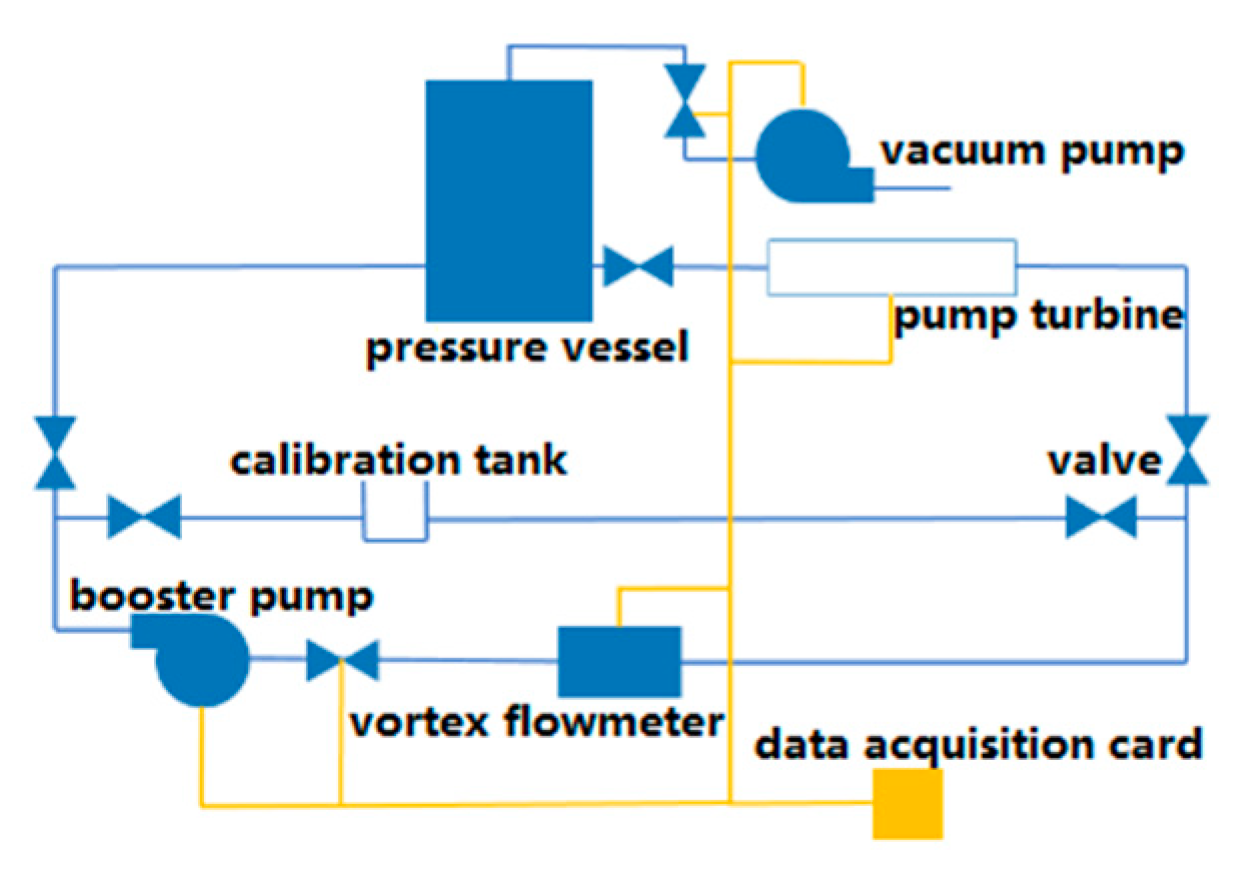
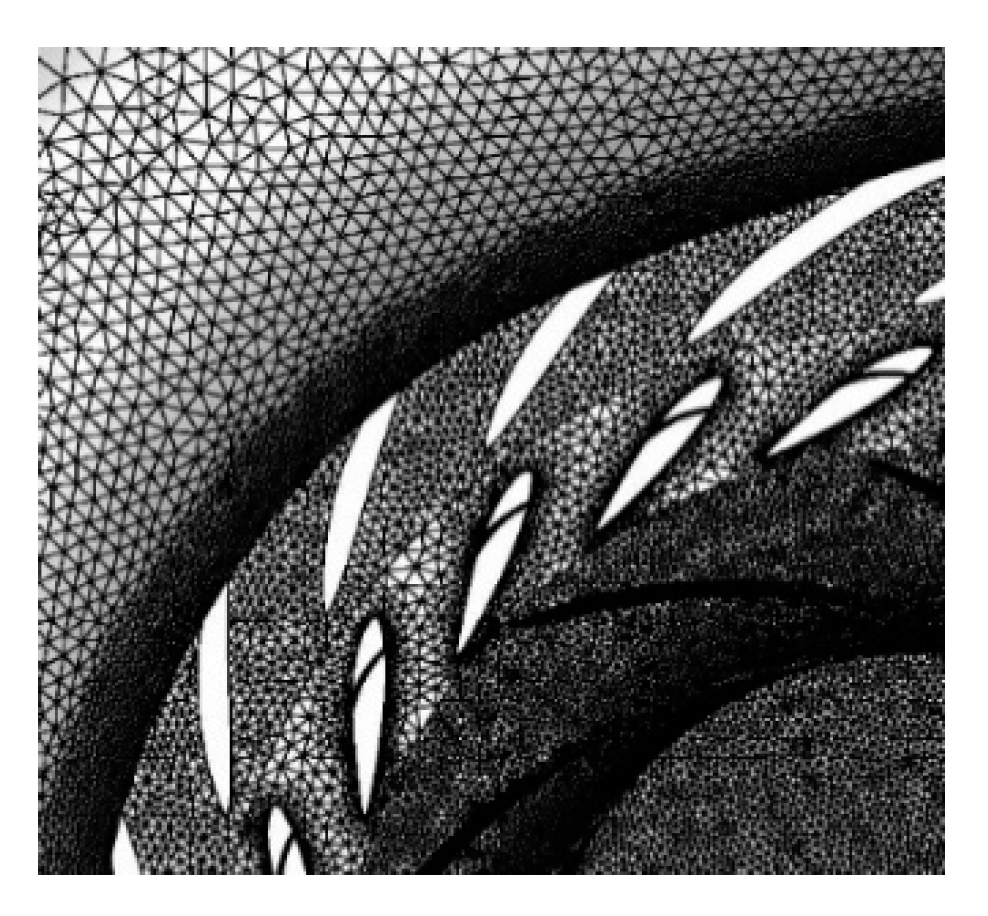
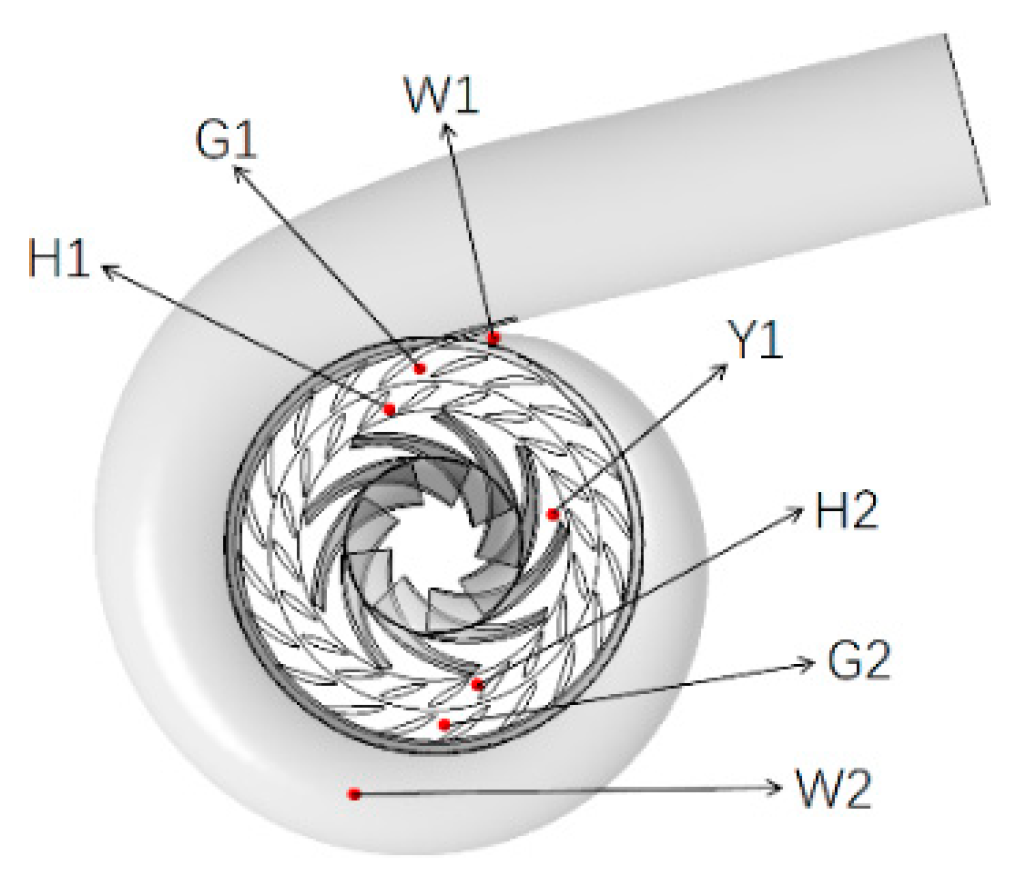





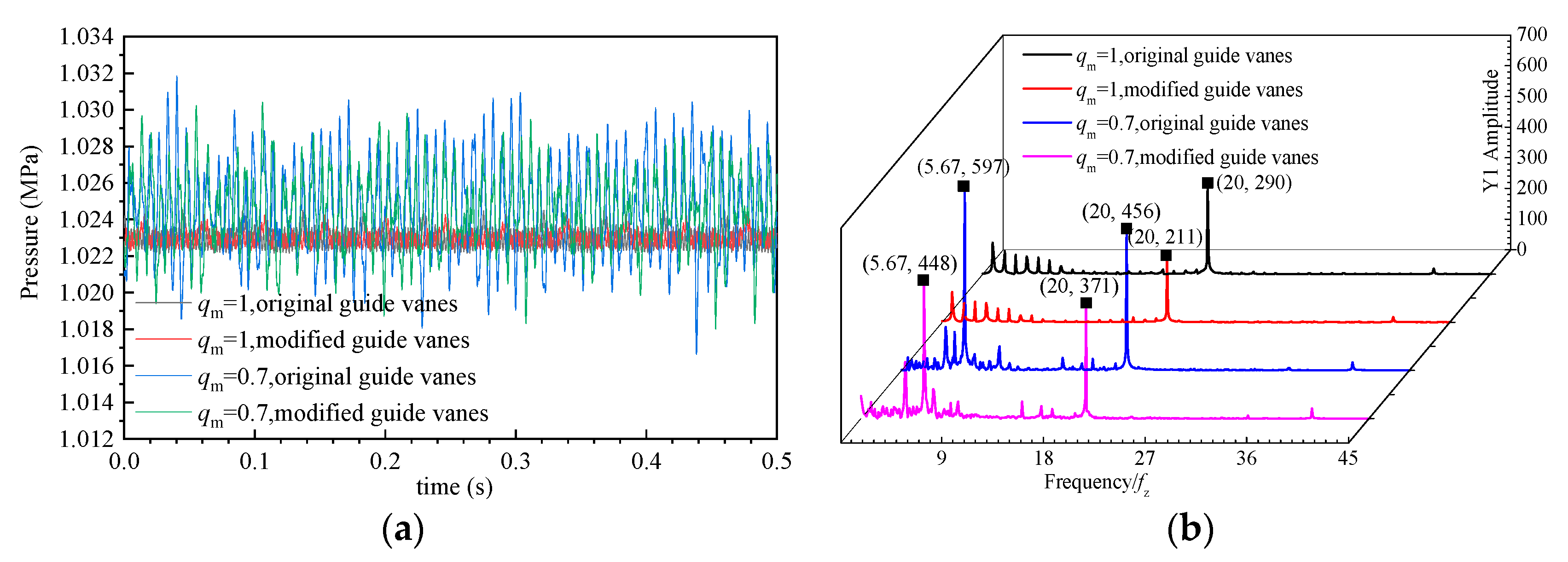
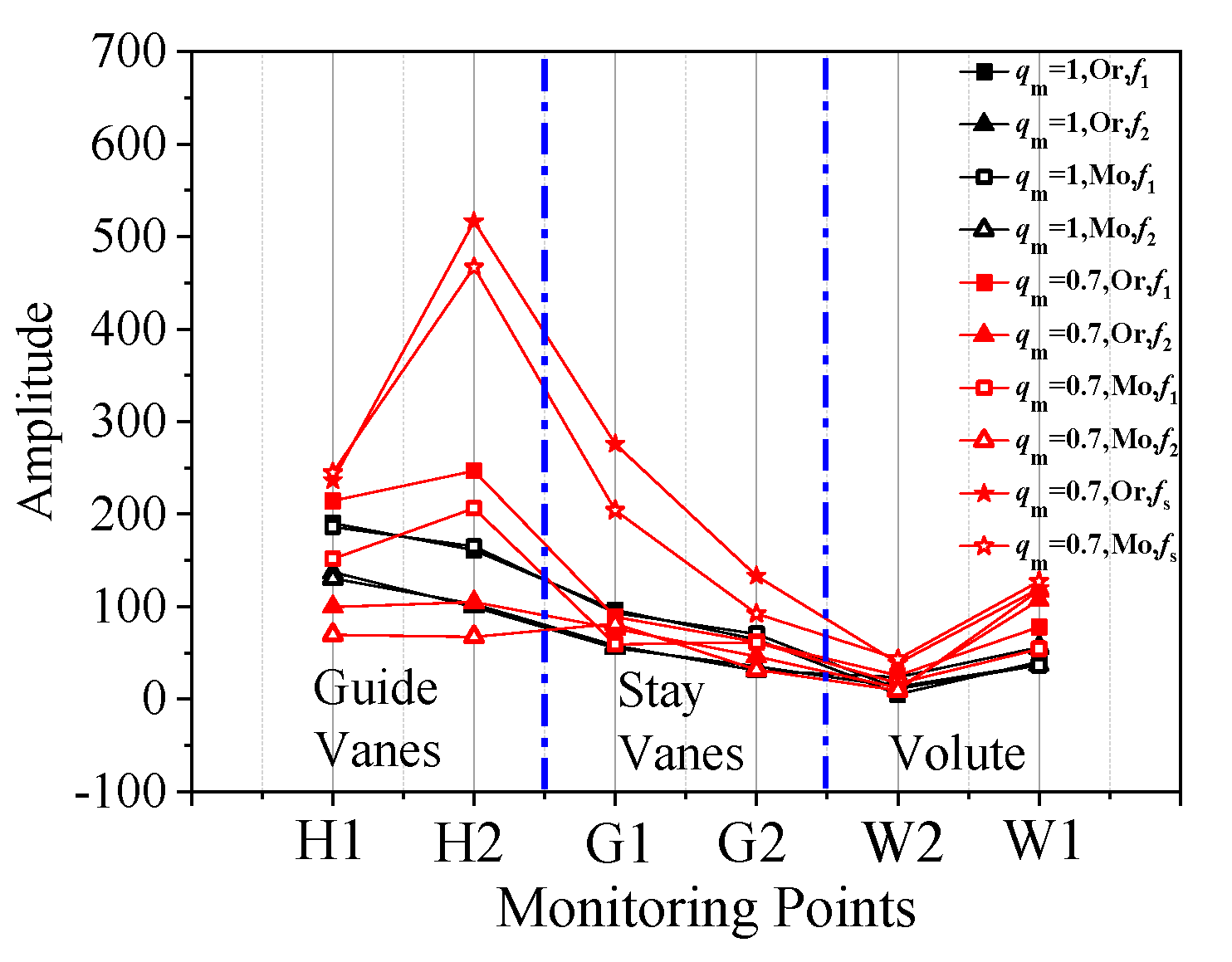
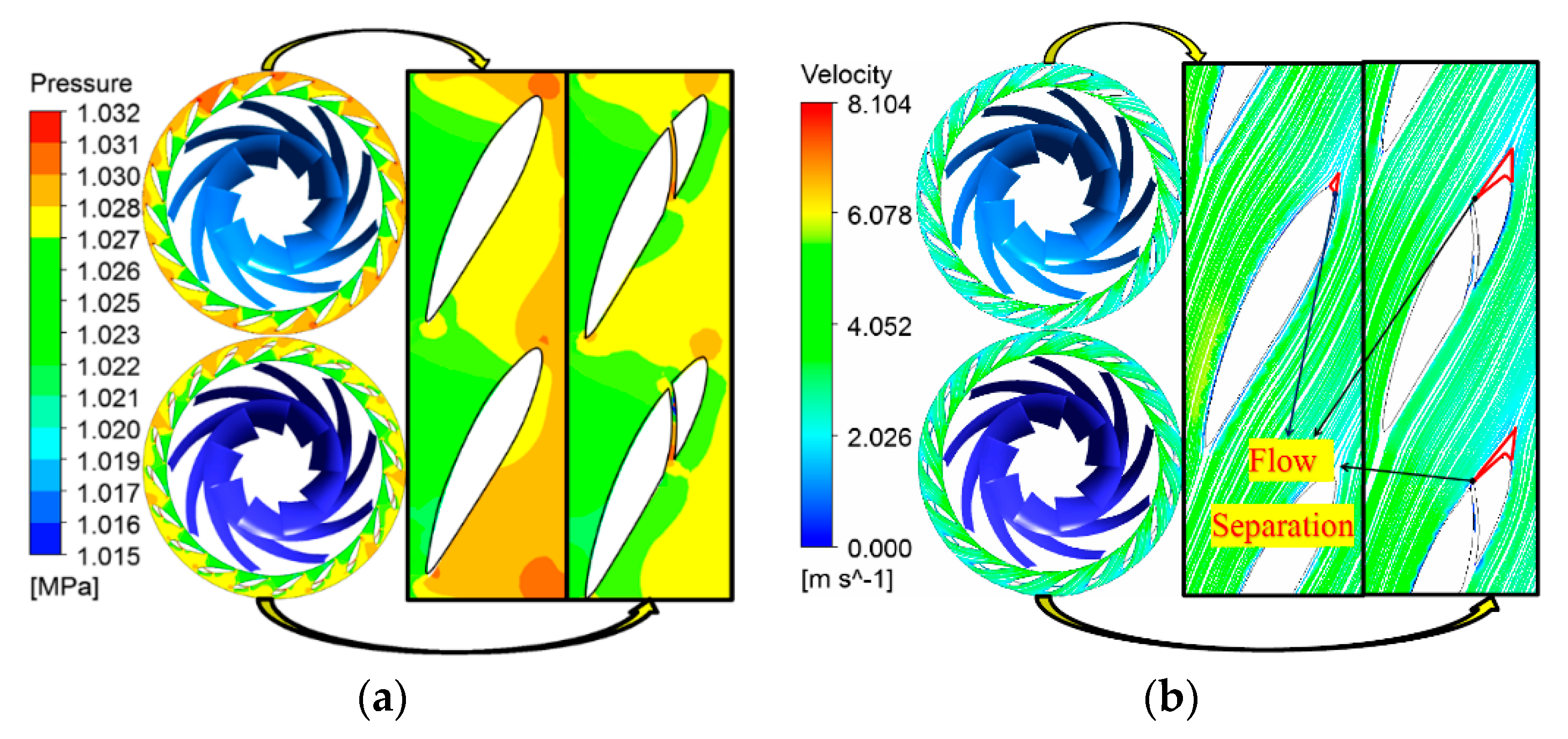
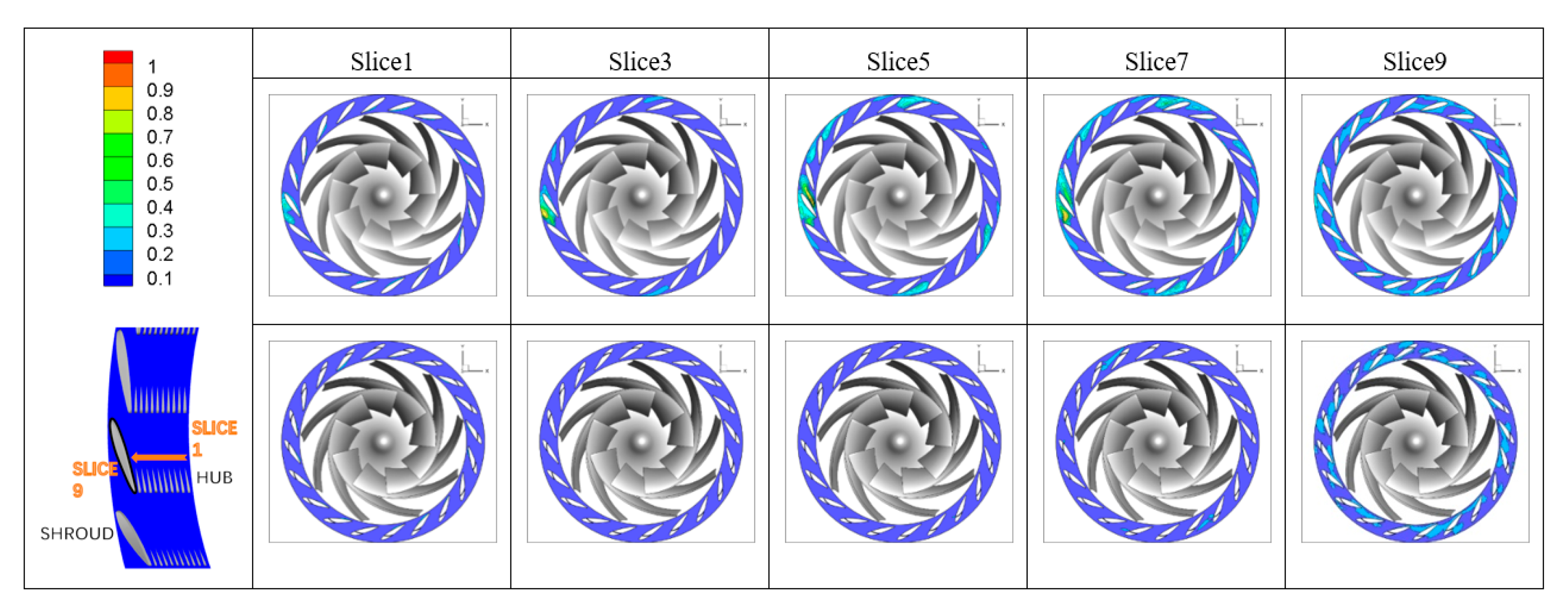

| Parameter | Din/mm | Dout/mm | Zr | Zg | Zs |
|---|---|---|---|---|---|
| Value | 80 | 80 | 9 | 20 | 20 |
| n (rev/min) | QN (kg/s) | HN (m) | ns | γ (°) |
|---|---|---|---|---|
| 1300 | 7.8 | 3.07 | 181 | 26 |
© 2020 by the authors. Licensee MDPI, Basel, Switzerland. This article is an open access article distributed under the terms and conditions of the Creative Commons Attribution (CC BY) license (http://creativecommons.org/licenses/by/4.0/).
Share and Cite
Liu, Y.; Ran, H.; Wang, D. Research on Groove Method to Suppress Stall in Pump Turbine. Energies 2020, 13, 3822. https://doi.org/10.3390/en13153822
Liu Y, Ran H, Wang D. Research on Groove Method to Suppress Stall in Pump Turbine. Energies. 2020; 13(15):3822. https://doi.org/10.3390/en13153822
Chicago/Turabian StyleLiu, Yong, Hongjuan Ran, and Dezhong Wang. 2020. "Research on Groove Method to Suppress Stall in Pump Turbine" Energies 13, no. 15: 3822. https://doi.org/10.3390/en13153822
APA StyleLiu, Y., Ran, H., & Wang, D. (2020). Research on Groove Method to Suppress Stall in Pump Turbine. Energies, 13(15), 3822. https://doi.org/10.3390/en13153822




